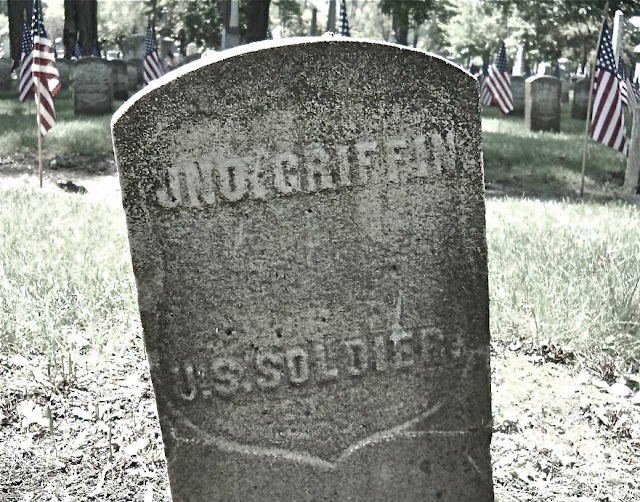Between The Mall And The BBQ At Elmwood

Memorial Day began as Decoration Day, after the Civil War, to honor those who died in service to their country. After WWI, it became a day to honor those who died in service in any war. Elmwood Cemetery has a Civil War Memorial plot, with 84 soldiers killed in the war and another 121 who are Civil War veterans buried in the plot. The flag flies over them night and day, in a rare tradition of remembrance.
How many U.S. soldiers have died while serving their country? Well, it depends a little on how you count them....if you are counting strictly deaths in battle, it's approximately 654,000, plus 4400 in Iraq and over 1000 in Afghanistan. Harvey Tinker was young, 22 years and 9 months...that's pretty typical of US war dead in general, although the soldiers who have died in Iraq and Afghanistan average closer to 27 years old.
Henry Conrad was already in his fifties when he served, although he did not die in battle.
Thus ends the Memorial Day portion of today's travels.
Elmwood Cemetery is a treasure for those who are interested in Detroit's history, full of the names of the streets and buildings of the city. Its meandering shady lanes and gently rolling, lightly wooded hills make it a great place to explore on foot or by bike. Many of Detroit's most gifted artists and craftsmen worked on memorials here, making sculptures and monuments worthy of museums and architecture tours. For example....
James B. Witherell died while returning to the north from fighting in the Indian Wars:"When the first news of secession came to the south he was under General Twiggs in Texas and the information came to him in April, 1861, while he was hunting. He promptly returned to camp and attended a meeting of officers, in which all who remained true to the flag, including himself, determined to return to the north. The boat by which they intended to return to the north lay in the harbor of Corpus Christi. He went ashore ln the evening, and being short-sighted it was supposed that he stumbled on the gang plank and fell into the water when he returned." (from The Early Bench and Bar of Detroit, by Robert B. Ross)
In a way, he could be considered an early casualty of the Civil War.
Near him, under an overgrown shrub, fallen face-up, I stumbled upon something for my esteemed blog-friend at The Night Train: Detroit....
I'm hopeful that this is the answer to at least one of the quiz questions.
Enjoy the long weekend.







Comments
Post a Comment
I'm always looking for something to read. Whatcha got?